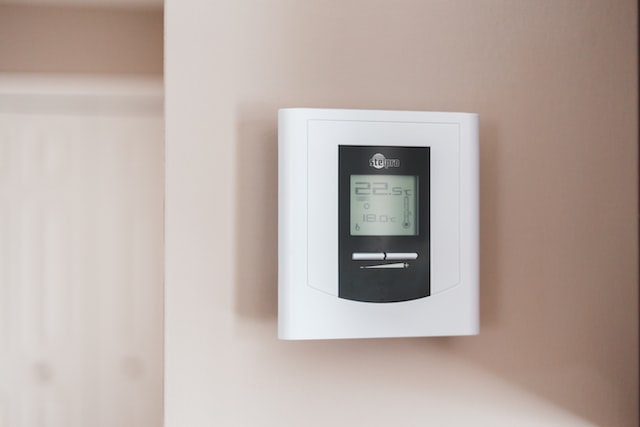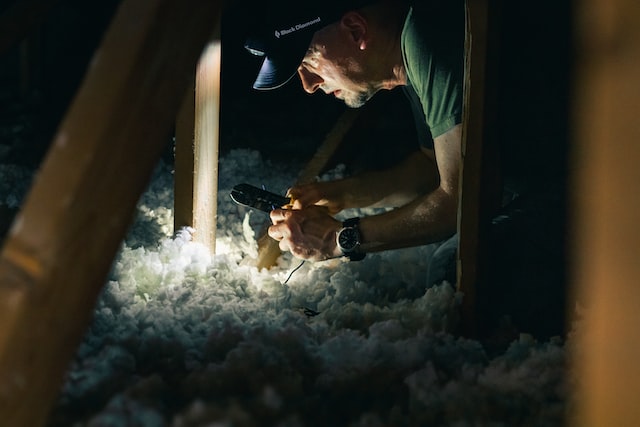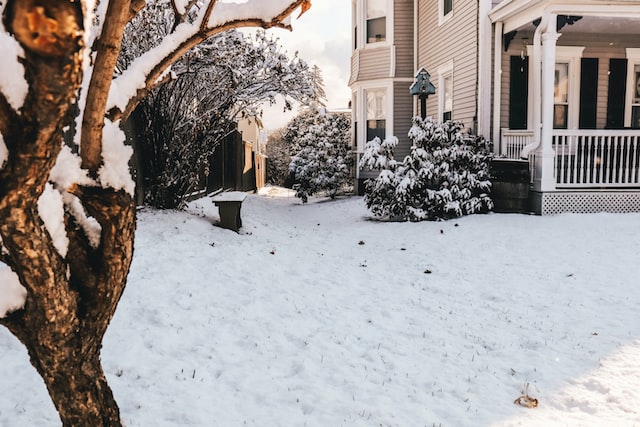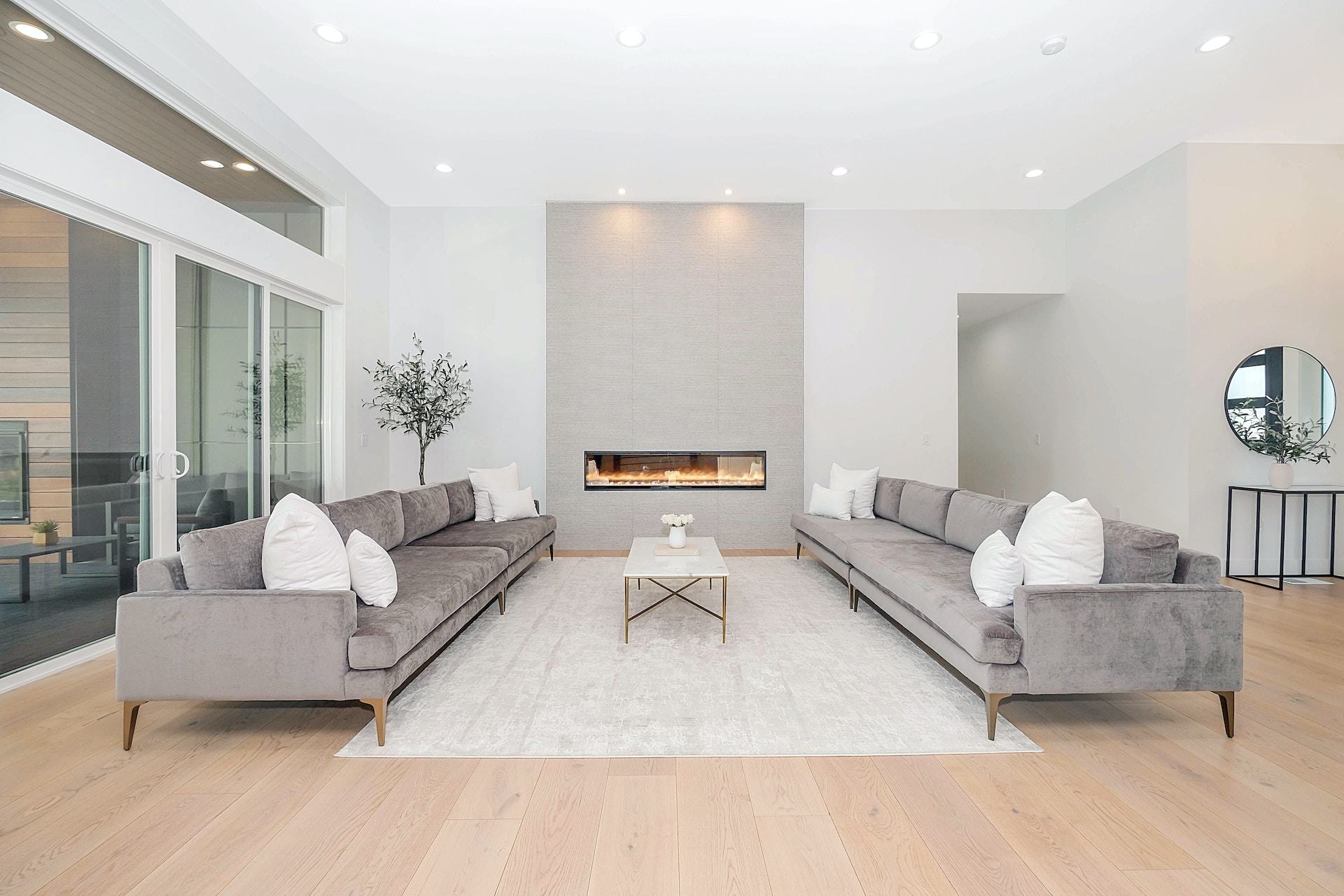Insulation is a material that protects your home from extreme weather, both hot and cold. Good insulation will keep your home at a steady temperature without constantly running your furnace or air conditioning unit. As an added bonus, insulation lowers your energy bill, as your home temperature is less likely to fluctuate with the weather.
Insulation is a smart idea if you have high heating bills and cooling bills, if your home is drafty, or if you feel the cold coming in through the walls. There are a few options for insulation, which are measured with the R-value – the capacity of insulating material to resist heat flow.
Benefits of Insulation
Insulation prevents airflow from entering your home when the temperature outside is cold or hot. Warm air in summer raises your indoor temperature, and cold winter air lowers it. Insulation works to prevent this, keeping your temperature comfortable regardless of the weather.
If you have the proper R-values of insulation, you can save up to 75% of the heat you pump into your home. The more stable your temperature inside, the less you’ll use your furnace, so your heating bill is going to drop. As a bonus, the less your HVAC system runs, the less maintenance it will need in its lifetime. You can save money on wear and tear in the long run.
Heating or cooling anything also affects the environment. When you run your HVAC system (for either the furnace or the air conditioning), this consumption increases your carbon footprint. Most homes use up to 5% more natural gas than necessary to heat improperly insulated homes. With proper insulation, your furnace doesn’t have to work as hard, lowering your carbon footprint.
Well-insulated homes hold more value than homes without insulation. For every $1 reduction in heating bills, your home’s value rises $20 on average. Whether you’re considering selling your home or not, it’s nice to know you can increase your comfort and the value of the house simultaneously. Some states offer rebates for insulation as an extra incentive, so find out if that’s an option where you live.
Insulation also works for outside noise. While it’s not designed for soundproofing, insulation dampens sound waves as they pass through, meaning less outside noise filtering into your home.
It’s estimated that most insulation pays for itself within six years in the heating and cooling bill reduction alone. Ceilings and walls are the main areas that need to be insulated, especially if you’re finding condensation in those places from the temperature differences. The majority of heat in your home escapes through the roof. Other significant sources of heat transfer include exterior doors and windows. It’s also worth considering draught sealing around your exterior doors and windows or using double-glazed glass to keep the outside air from seeping in.
Types of insulation
The best insulation varies by climate. Find a breakdown below of the various types on the market:
- Blanket batt and rolls – Blanket batt and rolls are the most standard insulation for walls. Made from fiberglass (though some are made from cotton and wool), this is among the most inexpensive insulation and a good DIY option. The materials are designed to fit between the standard wall studs, rafter, and floor joists. Standard fiberglass has an R-value between 2.9 and 3.8, while high-performance fiberglass has an R-value between 3.7 and 4.3. Batt insulation for ceilings, attics, crawl spaces, and unfinished floors tends to come in pre-cut sizes. Adjusting those sizes causes compression, which reduces its effectiveness.
- Spray foam insulation – Spray foam seals leaks and gaps in existing walls. When sprayed, the foam (polyurethane) expands and hardens into a solid foam. Pressure spray foam insulation is often used for larger areas. Closed-cell spray foam has the highest R-value at 6.2, which can make it expensive. Open-cell spray foam has an R-value of 3.7. You’d need a DIY kit to take this on yourself, though a professional is recommended.
- Blown-in insulation – Blown-in insulation has an R-value between 2.2 to 3.8. It’s great for insulating horizontal areas and is DIY friendly. This insulation is often made of fiberglass, rock wool, or reclaimed cellulose and is great for conforming to any location.
- Rigid foam panels – Rigid foam panels – also known as foam boards – are sturdier than batt and blanket rolls. These are great for insulating low-sloped, unvented roofs and floors. They reduce heat through wood and wall studs. They’re great for unfinished basement floors, walls, and ceilings because foam boards are offered in several materials and thicknesses. The R-value is between 4 and 6.5 per inch of thickness, which means foam boards are excellent for reducing energy consumption. Installing them in already-constructed homes means tearing apart the entire wall, which makes it impractical in certain situations.
- Rockwool – Rockwool is suitable for wood structures. It’s made from lava rock, is fire and moisture-resistant, and has an R-value of 3.3. It’s easy to install, though it does cost more than fiberglass. It’s also a great choice for sound dampening.
- Cellulose – Cellulose insulation (which is also known as loose-fill insulation) is made from recycled newspaper and denim. Cellulose is best utilized in attics and fluffs up as it settles. It doesn’t insulate well when too compact.
- Structural Insulated Panels – Structural Insulated Panels (SIPs) are heavy and large, so they require a crane to be installed. They are built to order, which means they’re difficult to obtain for DIY enthusiasts. They’re good for new constructions and provide strength and insulation for walls that otherwise have none.
- Insulating Concrete Forms – Insulating Concrete Forms (ICFs) are for newly poured wall construction. The cement is mixed with insulation, acting as both forms for energy efficiency. They consist of two reinforced foam panels with cement poured in between them, and the foam remains in place for the life of the concrete wall. IFCs aren’t readily available in typical home stores, so a DIYer may have to find a local seller who specializes. IFCs can strengthen the walls of your home and increase noise and temperature control. They’re a good choice for new construction or a major renovation.
- Concrete block insulation – If the gaps in your concrete walls are still accessible, stuffing them with insulation can make a big difference. Since this insulation is generally installed during construction, they’re not DIY-friendly and are best left to a professional.

Where to insulate your home
When considering where to add insulation to your home, this list of areas to focus on should help you narrow down where to start. People who decide to add insulation in piecemeal installments due to costs may want to start in these areas:
- The attic – Warm air rises. When you heat up your home, a lot of that heat escapes from the attic, so this is the best place to start insulation in the home. By insulating the attic floor, your heat will stay on the top floor of your home. Reduce losing heat to the outside by insulating the attic stairs and walls. Spray foam or batt rolls are the most common insulation for your attic.
- The walls – Once your attic is insulated, the warm air is going to try and escape somewhere else. Walls will be your next area to insulate to properly keep heat in your home. Walls that aren’t insulated will feel cold to the touch and let in drafts. You can add injection foam inside your walls to help keep you comfortable and warm inside your home. An added perk to wall insulation is it dampens sound, which can add a layer of privacy.
- Crawl space – By tackling each space with the most contact with outside temperatures, you hone in on your insulation’s effectiveness. Insulating your crawl space helps prevent your pipes from freezing during a snowstorm and keeps your ductwork warm. Heat will effectively move through your water and ducts without wasting time trying to warm them. Your floors will also retain warmth and ideally be warm enough to enjoy barefoot. The crawl space is often overlooked when it comes to insulation, but it can protect the space from mold, mildew, moisture, and unwanted pests.
- Basement – Insulation will turn a chilly unfinished basement into an energy-saving, comfortable space. Like the crawl space, insulating your basement helps with moisture, mold, and pests. Insulating this room’s walls, floors, and ceiling could make a big difference to your heating bill.
- Garage – Most people don’t use the garage aside from storage and a parking space. Consider insulating the wall that connects directly to your home to assist in heat loss prevention.
- Windows – Windows aren’t always the easiest place to insulate. You can replace loose and damaged weather stripping first, but if that’s not doing enough, consider a window replacement. New windows are designed to reduce heat loss and prevent condensation buildup.
- Doors – Drafty doors can lead to heat escaping. Ensure your weather stripping, door sweep, and all other components are in good condition. If the door needs to be realigned, consider that option.
- Ceilings and floors – Heat rises, so the best way to mitigate heat loss is through insulation in the floors and ceiling. You’ll help retain heat in each story of the home.
- Old or damaged insulation – Home insulation degrades over time, so yours may need a replacement. Old insulation is ineffective and could add to the problem if your home is cold and drafty.
Cost of home insulation
When researching the cost of insulating your home, remember that the area and type of insulation will make a big difference. Using the cheapest option – or an option unsuited for a specific area of the home – may save you money in the short term but may not be ideal for your return on investment. Spray foam insulation is the most expensive type, but it also comes with the highest return on investment.
Insulation is generally measured per board foot, which is one square foot by one inch thick. For blown-in insulation, you’re estimated to pay between $1,400 to $6,300 for your home, or an average of $2,900. Another way to look at insulation costs is per square foot, which is somewhere between $1 and $5. Labor for insulation is $0.25 to $0.50 per square foot, depending on the insulation used.
Insulation’s return on investment is over 100%. It’s considered one of the best home renovations a homeowner can do. Your insulation’s effectiveness is measured in R-value, ranging between two and eight. The higher the R-value, the better your insulation works to keep your home at the proper temperature.
Several factors can affect your costs for this renovation. The various types of insulation differ in cost, uses, and efficacy. The most common types of insulation are SIPs, blown-in, spray foam, and batt and roll blanket insulation. A professional can look at your home and make specific recommendations on what insulation will work best. They’ll be aware of the climate needs and what insulation works best in specific areas.
The size of the project makes a big difference since prices will most likely be calculated per square foot. When factoring in costs, don’t forget the prep work and clean-up, which also takes time and money.
The various rooms in your home will have different associated costs. Insulating a garage can cost between $1,500 to $8,000, but using batt rolls on the single wall connecting the garage to the home may only cost between $200 to $300. A crawl space may cost between $500 to $1,500 to insulate. Rigid board, fiberglass, or spray foam are the most common insulation types for these spaces. Basements are usually cheaper to insulate, as the ground also insulates it from temperature fluctuations.
Insulating your attic may cost between $1,500 to $4,000. Some people convert their attic to a liveable space, requiring the roof to be insulated instead. Insulating a roof may cost between $1,500 to $6,000, but a full attic conversion to a living space can cost around $40,000 (this cost usually includes replacing your roof at the same time). Heat escapes from the top of the home, so proper attic or roof insulation is the first thing you should consider.
Labor costs will include prep work beforehand. This can involve safely removing old insulation and repairing any hidden mold or mildew damage. You can expect an insulation removal or disposal fee. Once the original insulation is removed, a contractor will seal and patch the areas, then fill them with the insulation.
Most types of insulation cost between $1,000 to $3,000 for a specific space. Spray foam may cost more, as it requires special equipment and protective gear to install. It may be more expensive, but it comes with the highest R-value and is estimated to save up to $500 per year on energy savings alone.

How to save on home insulation costs
If you’re looking to save on insulation costs, you may be tempted to choose the cheapest option. While this will save you some money, there are other ways you can effectively lower your insulation costs.
Get as much information as you can beforehand. Many energy companies provide free energy audits, determining where you need new insulation and what type you should install in that area. At the same time, inquire about online, local, and federal rebates. An insulation professional should know what’s available, but take a look for yourself and see what you can learn. Get multiple estimates for the job – three to five estimates will give you a solid idea of the costs. These estimates should include a price per square foot and the R-value you’ll receive. Insulators tend to be slowest in early winter, so their prices are likely to drop in that timeframe.
You can remove the old insulation yourself to save costs. To do this, you’ll need to check with the city to ascertain removal requirements. You can also ask your contractor if they can assist you with the removal cost as a friendly gesture. Many people will consider taking on the job as a DIY project, but that’s not always recommended.
DIY vs. hiring professionals
If you’re insulating your attic, laying down batt and rolls or applying foam boards can look simple at a glance. These insulation types need to be cut perfectly to properly insulate the space. If you make a mistake, you’ll need more insulation, which drives the cost up. If you’re insulating other areas, such as walls or tight spaces, you’ll have to crawl inside; you may find the already time-consuming job of insulating to be aggravating.
Beyond the logistics, there’s a technical aspect to insulation. First, you’ll need to understand how to safely remove the old insulation and what to do with it. Foam boards, batt, and rolls are relatively simple but must be cut to exact measurements. You’ll need to rent a machine if you plan to use blow-in cellulose insulation. Insulation installation has a steep learning curve and may take you longer than you expected at first. On top of that, any damage to the home will require repair.
A contractor will come in and consider how to accomplish the job safely. The original insulation might contain asbestos if your home was built before 1975. Asbestos is a naturally occurring mineral that was widely used in the past for its heat resistance, durability, and insulating properties. However, exposure to asbestos fibers can lead to several serious health risks. The main health risks associated with asbestos exposure are lung cancer, mesothelioma (a rare form of cancer that affects the lining of the lungs), asbestosis (a lung disease that causes scarring and shortness of breath), and pleural thickening (a condition in which the tissue that surrounds the lungs thickens and can cause difficulty breathing). These risks are generally associated with long-term exposure to high levels of asbestos fibers, and the risk of developing these health problems increases with the duration and level of asbestos exposure. Asbestos removal is the process of removing asbestos-containing materials (ACM) from a building. ACM can include insulation, roofing, flooring, and other materials containing asbestos fibers. This process should only be performed by trained and certified professionals using proper protective equipment and following all safety regulations.
New fiberglass is also a dangerous material to handle. If it gets embedded in the skin or inhaled in the lungs, it can lead to a serious illness. Insulating can be a complicated job, and if heights are involved or you need to insulate around electrical hazards, you’ll need the materials and the know-how to combat the situation.
Most people DIY insulation in order to save money. This is possible for a basement or an attic, where the job is straightforward. Laying insulation of any type is time-consuming, and a professional will be a lot faster at getting the job done. They can mitigate costs by getting into the walls without tearing them down. They also come with all the tools, machines, and safety equipment at the ready, which you’ll have to factor into your cost comparison.
Ultimately, the benefits of hiring a professional largely outweigh the costs for this job, especially in hard-to-reach areas of the home. Insulation is a troublesome product that is not only time-consuming but finicky to work with. It won’t be effective if installed incorrectly, and you’ll spend more money fixing the issue. A professional may cost more, but they’ll get the job done correctly and efficiently.
Considerations when hiring a professional
When considering hiring a professional, there are a few things you should take into account. Any contractor you hire should be fully licensed and insured in case something goes wrong. Check their reviews to find out if they’re reputable. Do they have references they can provide? How long have they been in business? Do they have worker’s compensation insurance? Who exactly will be doing the work? These are all great questions to ask any professionals you’re considering hiring.
It’s important to get multiple quotes for insulation jobs. Ideally, contractors will recommend similar approaches to your home’s insulation needs. An estimate should include a price per square foot and an R-value. Ask if your contractor will warranty or guarantee their work and about the protective measures they take. You’ll also want to know what they do if they find needed repairs. Can they handle those repairs themselves? Finally, you’ll want their best estimate of how long the project will take.

Winter is right around the corner, so this is an excellent time to consider insulation for your home. Insulation is a game changer when heating and keeping heat inside your home. Your furnace and radiant flooring will do less work, and the heat will stay where you need it. Insulation isn’t only helpful for the winter. It keeps the heat out of your home in the summer as well. Insulating your home has an excellent return on investment and could save you thousands of dollars in heating and cooling over time.




